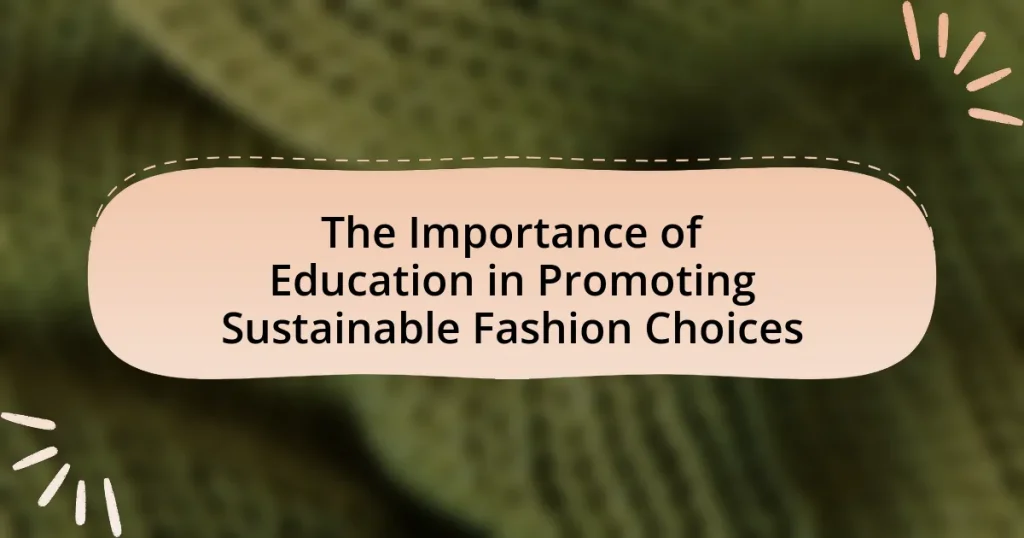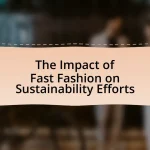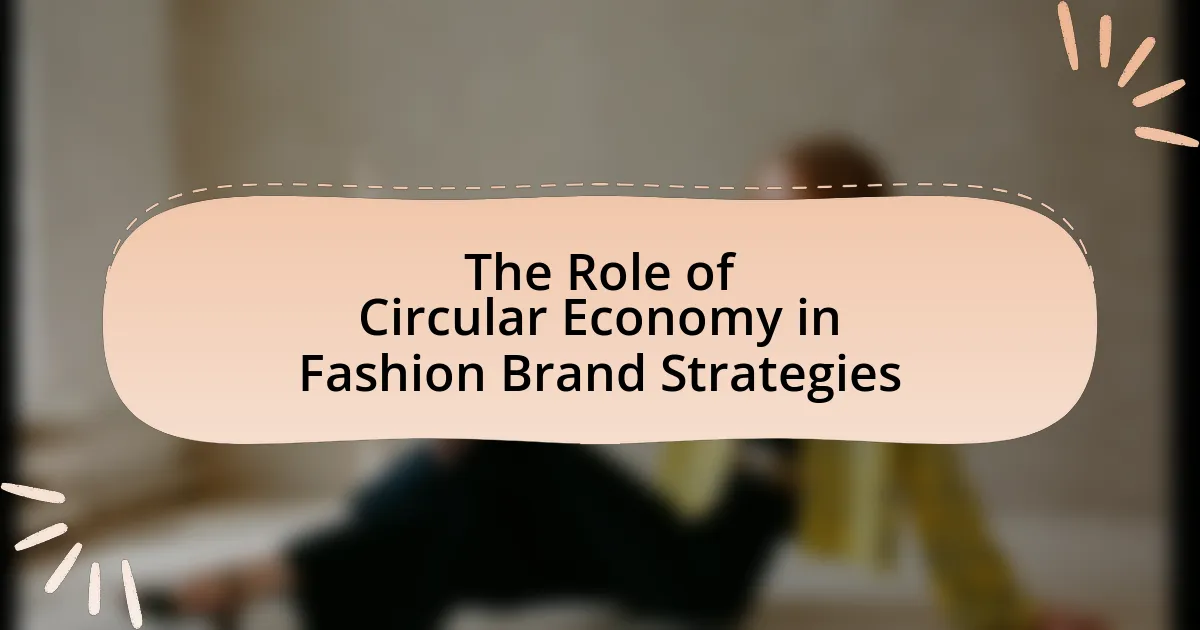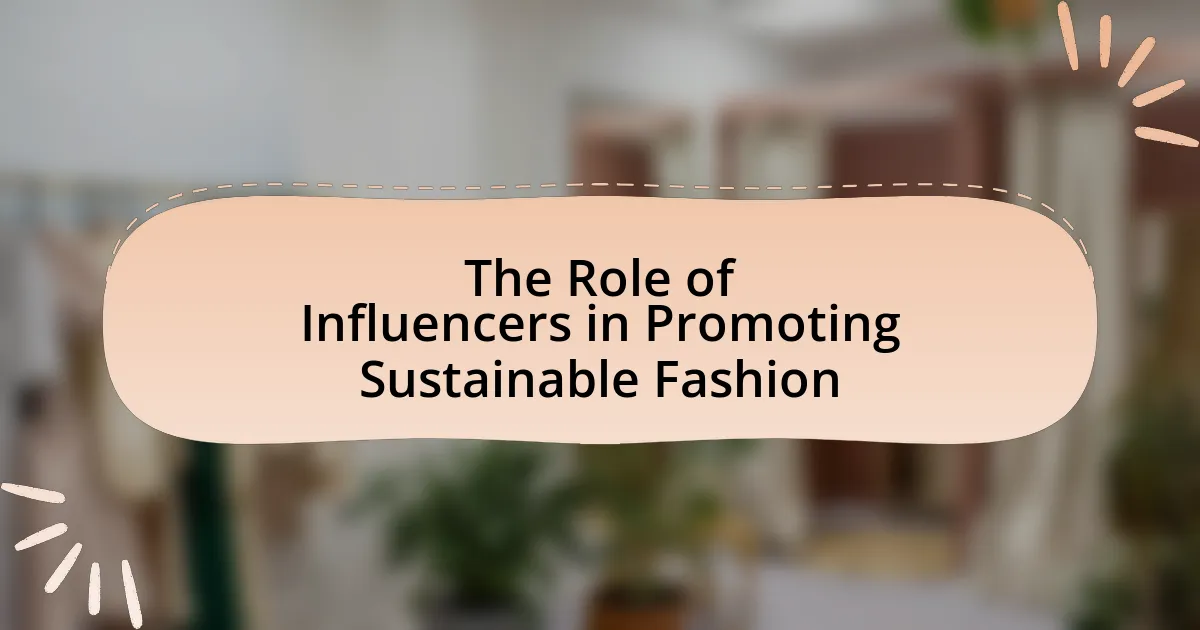The article emphasizes the critical role of education in promoting sustainable fashion choices, highlighting how knowledge about the environmental and social impacts of the fashion industry influences consumer behavior. It discusses the importance of awareness in driving sustainable purchasing decisions and the necessity of integrating sustainable fashion education into curricula for future generations. The article also addresses challenges in educating consumers about sustainable practices, the impact of cultural attitudes, and the role of community initiatives and collaborations in enhancing education on sustainable fashion. Key components of effective education, such as experiential learning and stakeholder engagement, are outlined, along with practical steps individuals can take to support sustainable fashion.

What is the Importance of Education in Promoting Sustainable Fashion Choices?
Education is crucial in promoting sustainable fashion choices as it equips individuals with knowledge about the environmental and social impacts of the fashion industry. By understanding concepts such as ethical sourcing, waste reduction, and the benefits of sustainable materials, consumers can make informed decisions that support eco-friendly practices. Research indicates that educated consumers are more likely to prioritize sustainability, with a study from the Journal of Fashion Marketing and Management showing that awareness of environmental issues significantly influences purchasing behavior. Thus, education fosters a culture of sustainability within the fashion sector, encouraging responsible consumption and production.
How does education influence consumer behavior in fashion?
Education significantly influences consumer behavior in fashion by increasing awareness of sustainability and ethical practices. Consumers with higher education levels tend to prioritize brands that demonstrate social responsibility and environmental stewardship. Research conducted by the Journal of Fashion Marketing and Management indicates that educated consumers are more likely to engage in sustainable purchasing behaviors, such as buying eco-friendly products and supporting ethical brands. This correlation suggests that education equips individuals with the knowledge to make informed choices, ultimately shaping their fashion consumption patterns towards more sustainable options.
What role does awareness play in sustainable fashion choices?
Awareness plays a crucial role in sustainable fashion choices by informing consumers about the environmental and social impacts of their purchasing decisions. When individuals are educated about issues such as textile waste, carbon emissions, and labor practices, they are more likely to make informed choices that prioritize sustainability. Research indicates that 66% of consumers are willing to pay more for sustainable brands when they understand the benefits, highlighting the direct correlation between awareness and consumer behavior. This understanding fosters a demand for ethical practices in the fashion industry, ultimately driving brands to adopt more sustainable methods.
How can education change perceptions of fast fashion?
Education can change perceptions of fast fashion by increasing awareness of its environmental and social impacts. Through educational programs, individuals learn about the negative consequences of fast fashion, such as pollution, waste, and exploitation of labor. For instance, a study by the Ellen MacArthur Foundation highlights that the fashion industry is responsible for 10% of global carbon emissions and significant water usage. By integrating sustainability into curricula, educational institutions can foster critical thinking and encourage consumers to make informed choices, ultimately shifting their attitudes towards more sustainable fashion practices.
Why is sustainable fashion education essential for future generations?
Sustainable fashion education is essential for future generations because it equips them with the knowledge and skills needed to make environmentally responsible choices in their consumption and production of clothing. This education fosters awareness of the negative impacts of fast fashion, such as pollution and waste, which statistics show contribute to 10% of global carbon emissions and significant water usage. By understanding these issues, future generations can advocate for sustainable practices, support ethical brands, and innovate solutions that promote a circular economy in the fashion industry.
What are the long-term benefits of educating youth about sustainable fashion?
Educating youth about sustainable fashion leads to long-term benefits such as fostering environmentally conscious consumers and promoting ethical production practices. By instilling knowledge about the environmental impact of fast fashion, young individuals are more likely to make informed purchasing decisions that prioritize sustainability. Research indicates that consumers who are educated about sustainable practices tend to support brands that adhere to ethical standards, thereby driving demand for sustainable products. This shift not only reduces waste and pollution but also encourages the fashion industry to adopt more sustainable practices, ultimately contributing to a healthier planet.
How can educational institutions integrate sustainable fashion into their curricula?
Educational institutions can integrate sustainable fashion into their curricula by incorporating interdisciplinary courses that cover environmental science, ethics, and design principles related to sustainable practices in the fashion industry. For instance, programs can include modules on the lifecycle of textiles, the impact of fast fashion on the environment, and sustainable sourcing methods. Research indicates that educational initiatives focused on sustainability can significantly influence students’ attitudes and behaviors towards eco-friendly practices, as seen in studies conducted by the Journal of Fashion Marketing and Management, which highlight the effectiveness of sustainability education in shaping consumer choices.
What challenges exist in educating about sustainable fashion?
Educating about sustainable fashion faces several challenges, including a lack of awareness and understanding among consumers. Many individuals are not familiar with the environmental and social impacts of the fashion industry, which hinders their ability to make informed choices. Research indicates that approximately 60% of consumers are unaware of the concept of sustainable fashion, highlighting the need for effective educational initiatives. Additionally, the complexity of sustainable practices, such as understanding certifications and supply chains, can overwhelm consumers, making it difficult for them to engage with sustainable options. Furthermore, the fast-paced nature of fashion trends often contradicts the principles of sustainability, leading to confusion and apathy among consumers. These challenges necessitate targeted educational efforts to raise awareness and simplify the concepts surrounding sustainable fashion.
How do cultural attitudes affect the acceptance of sustainable fashion education?
Cultural attitudes significantly influence the acceptance of sustainable fashion education by shaping perceptions of environmental responsibility and consumer behavior. In cultures that prioritize sustainability and ethical consumption, individuals are more likely to embrace educational initiatives focused on sustainable fashion. For instance, a study published in the Journal of Fashion Marketing and Management found that consumers in countries with strong environmental regulations, like Sweden, show higher acceptance of sustainable fashion practices compared to those in regions with less emphasis on sustainability, such as the United States. This indicates that cultural values directly impact the willingness to engage with and adopt sustainable fashion education.
What barriers do educators face in promoting sustainable fashion concepts?
Educators face several barriers in promoting sustainable fashion concepts, including a lack of resources, insufficient training, and limited institutional support. The scarcity of educational materials and funding restricts the ability to implement comprehensive curricula on sustainable fashion. Additionally, many educators lack specialized training in sustainability, which hampers their confidence and effectiveness in teaching these concepts. Research by the Ellen MacArthur Foundation indicates that only 30% of fashion educators incorporate sustainability into their teaching, highlighting the need for greater institutional commitment and professional development opportunities to overcome these challenges.
How can collaboration enhance education on sustainable fashion?
Collaboration can enhance education on sustainable fashion by fostering interdisciplinary approaches that integrate diverse perspectives and expertise. When educational institutions partner with industry stakeholders, such as fashion brands, environmental organizations, and academic researchers, they create a comprehensive learning environment that addresses the complexities of sustainable practices. For instance, a study by the Ellen MacArthur Foundation highlights that collaborative initiatives can lead to innovative curriculum development, enabling students to engage with real-world challenges and solutions in sustainable fashion. This synergy not only enriches the educational experience but also equips learners with practical skills and knowledge essential for driving change in the fashion industry.
What role do NGOs and community organizations play in sustainable fashion education?
NGOs and community organizations play a crucial role in sustainable fashion education by raising awareness, providing resources, and facilitating workshops that promote eco-friendly practices. These organizations often engage in outreach programs that educate consumers about the environmental and social impacts of the fashion industry, thereby fostering informed decision-making. For instance, initiatives like Fashion Revolution and the Sustainable Apparel Coalition have successfully mobilized communities to advocate for transparency and ethical practices in fashion. Their efforts are supported by research indicating that educational interventions can significantly influence consumer behavior towards more sustainable choices, as highlighted in studies published by the Journal of Fashion Marketing and Management.
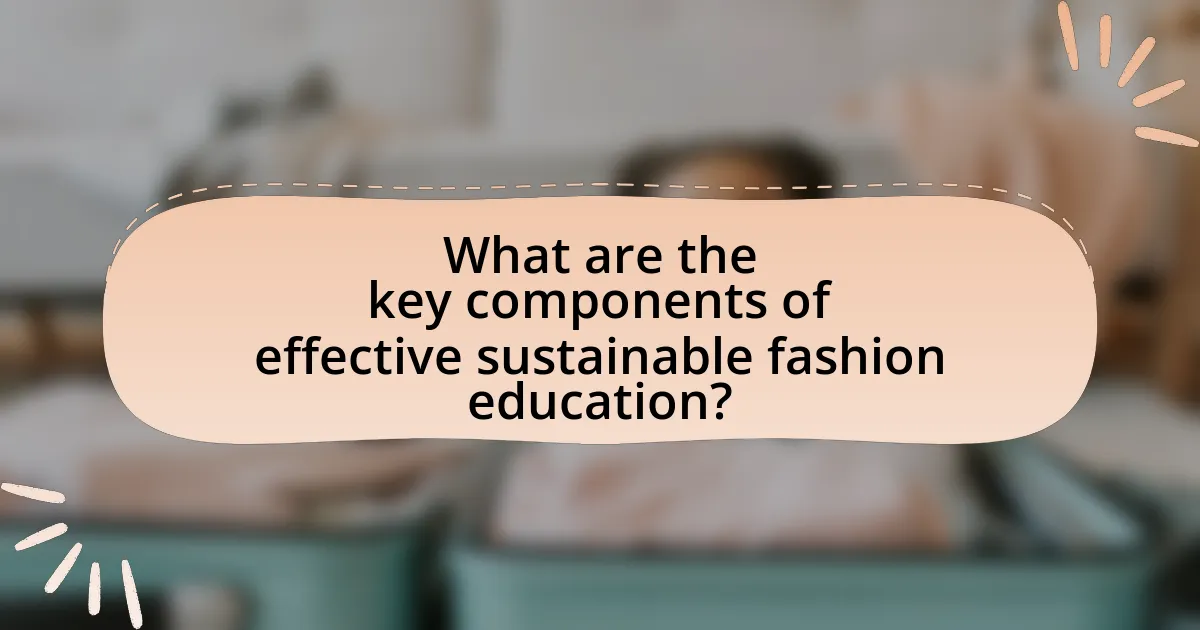
What are the key components of effective sustainable fashion education?
The key components of effective sustainable fashion education include curriculum integration, experiential learning, and stakeholder engagement. Curriculum integration ensures that sustainability principles are embedded within fashion design, production, and marketing courses, allowing students to understand the environmental and social impacts of their choices. Experiential learning, such as hands-on projects and collaborations with sustainable brands, provides practical experience and reinforces theoretical knowledge. Stakeholder engagement involves partnerships with industry professionals, NGOs, and communities, fostering a holistic understanding of sustainable practices and encouraging students to apply their learning in real-world contexts. These components collectively enhance the educational experience and prepare students to make informed, responsible decisions in the fashion industry.
How can practical experiences enhance learning about sustainable fashion?
Practical experiences enhance learning about sustainable fashion by providing hands-on opportunities to apply theoretical knowledge in real-world contexts. Engaging in activities such as upcycling workshops, sustainable design projects, or internships with eco-friendly brands allows learners to understand the complexities of sustainable practices, including material sourcing, production processes, and consumer behavior. Research indicates that experiential learning significantly improves retention and comprehension, as students can directly observe the impact of their choices on the environment and society. For instance, a study published in the Journal of Fashion Marketing and Management found that students who participated in practical sustainability projects demonstrated a deeper understanding of sustainable fashion principles compared to those who only received traditional classroom instruction.
What types of hands-on activities can be included in sustainable fashion education?
Hands-on activities in sustainable fashion education can include upcycling workshops, where participants transform old garments into new designs, and sewing classes that focus on using sustainable materials. These activities engage learners in practical applications of sustainable practices, fostering creativity and awareness of environmental impacts. For instance, a study by the Ellen MacArthur Foundation highlights that upcycling can significantly reduce textile waste, demonstrating the effectiveness of such hands-on experiences in promoting sustainable fashion choices.
How do internships and workshops contribute to understanding sustainable practices?
Internships and workshops significantly enhance understanding of sustainable practices by providing hands-on experience and practical knowledge. These programs immerse participants in real-world scenarios where they can observe and engage with sustainable methods, such as eco-friendly materials and ethical production processes. For instance, a study by the Journal of Cleaner Production found that experiential learning through internships leads to a 30% increase in participants’ knowledge of sustainability concepts compared to traditional classroom settings. This direct involvement fosters critical thinking and problem-solving skills essential for implementing sustainable practices in various industries, particularly in fashion.
What resources are available for educators teaching sustainable fashion?
Educators teaching sustainable fashion have access to a variety of resources, including online courses, curriculum guides, and educational organizations focused on sustainability. For instance, the Sustainable Fashion Academy offers online courses that provide comprehensive insights into sustainable practices in the fashion industry. Additionally, organizations like Fashion Revolution provide educational materials and toolkits that help educators incorporate sustainability into their teaching. The Ellen MacArthur Foundation also offers resources that focus on circular economy principles, which are crucial for sustainable fashion education. These resources are designed to equip educators with the knowledge and tools necessary to effectively teach sustainable fashion concepts.
Which online platforms offer courses on sustainable fashion?
Online platforms that offer courses on sustainable fashion include Coursera, edX, and FutureLearn. These platforms provide a variety of courses focusing on sustainable practices in the fashion industry, often developed in collaboration with universities and industry experts. For example, Coursera features courses from institutions like the University of Copenhagen, which explores sustainable fashion design and production methods. Similarly, edX offers courses from the Massachusetts Institute of Technology that delve into the environmental impacts of fashion. FutureLearn also provides courses that cover ethical fashion and sustainability, emphasizing the importance of education in promoting responsible consumer choices in the fashion sector.
How can educators access sustainable fashion case studies and materials?
Educators can access sustainable fashion case studies and materials through various online platforms, academic journals, and educational organizations focused on sustainability. Websites such as the Sustainable Apparel Coalition and the Ellen MacArthur Foundation provide resources, including case studies and reports, that are specifically tailored for educational purposes. Additionally, academic journals like the Journal of Fashion Technology & Textile Engineering publish research articles that explore sustainable practices in fashion, offering valuable insights and case studies. Furthermore, educators can utilize platforms like ResearchGate to connect with researchers and access a wide range of studies related to sustainable fashion.
What impact does technology have on sustainable fashion education?
Technology significantly enhances sustainable fashion education by providing innovative tools and platforms for learning. Online courses, virtual reality experiences, and interactive apps facilitate access to information about sustainable practices, enabling a broader audience to engage with the subject. For instance, platforms like Coursera and edX offer courses on sustainable fashion, reaching thousands of learners globally. Additionally, technology enables the use of data analytics to track and measure sustainability efforts, allowing students to understand the impact of their choices. This integration of technology not only democratizes education but also fosters a more informed and responsible consumer base in the fashion industry.
How can digital tools facilitate learning about sustainable practices?
Digital tools facilitate learning about sustainable practices by providing accessible resources, interactive platforms, and real-time data analysis. These tools, such as online courses, mobile applications, and social media, enable users to engage with sustainability concepts through multimedia content, fostering a deeper understanding. For instance, platforms like Coursera and edX offer courses on sustainable development, allowing learners to access expert knowledge from institutions worldwide. Additionally, apps like Good On You provide consumers with information on fashion brands’ sustainability practices, empowering informed purchasing decisions. Research indicates that digital learning environments can enhance knowledge retention and engagement, making them effective for promoting sustainable practices.
What role do social media and influencers play in educating consumers?
Social media and influencers play a crucial role in educating consumers about sustainable fashion choices by disseminating information and promoting awareness through engaging content. Influencers leverage their platforms to share insights on sustainable practices, ethical brands, and the environmental impact of fashion, effectively reaching a broad audience. For instance, a study by the Global Fashion Agenda found that 62% of consumers are influenced by social media when making sustainable fashion decisions, highlighting the significant impact of these platforms on consumer behavior.
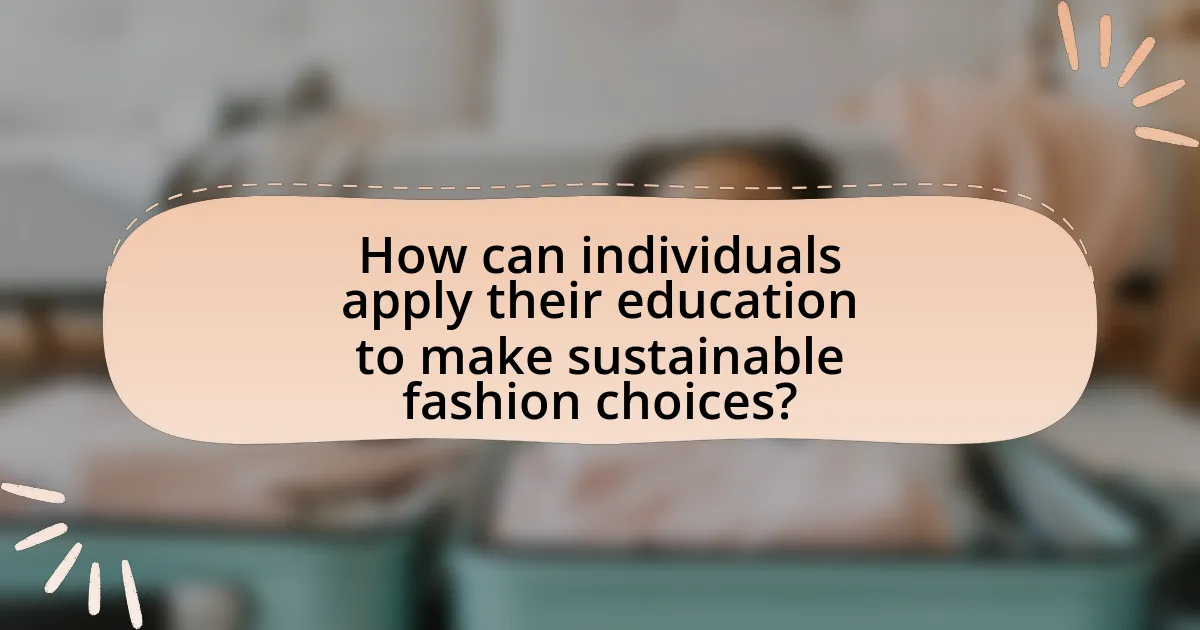
How can individuals apply their education to make sustainable fashion choices?
Individuals can apply their education to make sustainable fashion choices by utilizing knowledge about environmental impacts, ethical sourcing, and sustainable materials. For instance, understanding the lifecycle of clothing can help individuals choose brands that prioritize eco-friendly practices, such as using organic cotton or recycled materials. Research indicates that the fashion industry is responsible for 10% of global carbon emissions, highlighting the importance of informed consumer choices. By leveraging their education, individuals can advocate for transparency in supply chains and support companies that demonstrate a commitment to sustainability, thereby contributing to a more responsible fashion ecosystem.
What practical steps can consumers take to support sustainable fashion?
Consumers can support sustainable fashion by choosing to buy from brands that prioritize ethical production practices and use eco-friendly materials. This choice directly impacts the demand for sustainable practices in the fashion industry. For instance, a report by the Global Fashion Agenda indicates that sustainable brands often use organic cotton, recycled materials, and fair labor practices, which contribute to reducing environmental impact and promoting social responsibility. Additionally, consumers can extend the lifecycle of their clothing by repairing, recycling, or donating garments, which helps minimize waste. According to the Ellen MacArthur Foundation, extending the life of clothes by just nine months can reduce carbon, water, and waste footprints by around 20-30%. By making informed purchasing decisions and adopting responsible clothing habits, consumers play a crucial role in fostering a more sustainable fashion ecosystem.
How can individuals assess the sustainability of their clothing choices?
Individuals can assess the sustainability of their clothing choices by evaluating the materials, production processes, and brand practices associated with the garments. Sustainable clothing often utilizes organic or recycled materials, which reduce environmental impact; for example, organic cotton uses 91% less water than conventional cotton. Additionally, individuals should consider the ethical practices of brands, such as fair labor conditions and transparency in supply chains. Research indicates that brands with certifications like Fair Trade or Global Organic Textile Standard (GOTS) adhere to higher sustainability standards. By examining these factors, individuals can make informed decisions that align with sustainable fashion principles.
What are some tips for building a sustainable wardrobe?
To build a sustainable wardrobe, prioritize quality over quantity by selecting durable, timeless pieces made from eco-friendly materials. Research indicates that clothing made from organic cotton, Tencel, or recycled fabrics significantly reduces environmental impact compared to conventional materials. Additionally, consider shopping from brands that practice ethical manufacturing and transparency in their supply chains, as this supports sustainable practices and reduces waste. Incorporating second-hand clothing into your wardrobe also promotes sustainability, as it extends the lifecycle of garments and minimizes the demand for new production. Finally, educate yourself on the environmental impact of fashion choices, as informed consumers are more likely to make sustainable decisions.
How can community initiatives promote sustainable fashion education?
Community initiatives can promote sustainable fashion education by organizing workshops, events, and campaigns that raise awareness about sustainable practices in the fashion industry. These initiatives often engage local designers, educators, and consumers to share knowledge on topics such as eco-friendly materials, ethical production methods, and the impact of fast fashion. For instance, a study by the Ellen MacArthur Foundation highlights that community-led educational programs can significantly increase consumer understanding of sustainability, leading to more informed purchasing decisions. By fostering collaboration and providing accessible resources, community initiatives effectively enhance public awareness and encourage sustainable fashion choices.
What are the best practices for advocating sustainable fashion in local communities?
The best practices for advocating sustainable fashion in local communities include organizing educational workshops, collaborating with local businesses, and promoting community events focused on sustainable practices. Educational workshops can teach community members about the environmental impact of fast fashion and the benefits of sustainable alternatives, fostering informed consumer choices. Collaborating with local businesses can create partnerships that promote sustainable products and practices, enhancing visibility and accessibility. Additionally, community events such as clothing swaps or sustainable fashion shows can engage residents, encouraging participation and awareness. These practices have been shown to increase community involvement and support for sustainable initiatives, as evidenced by studies indicating that local engagement significantly boosts the adoption of sustainable behaviors.
